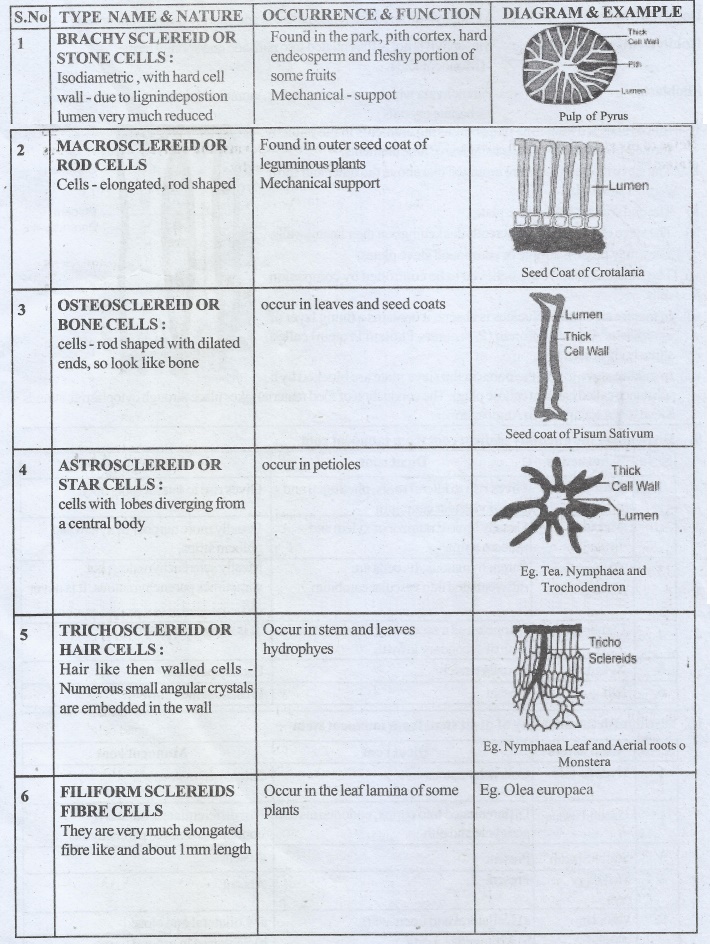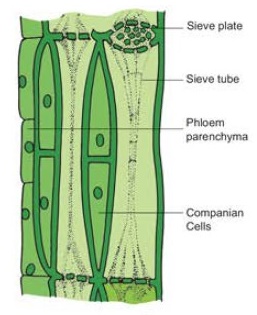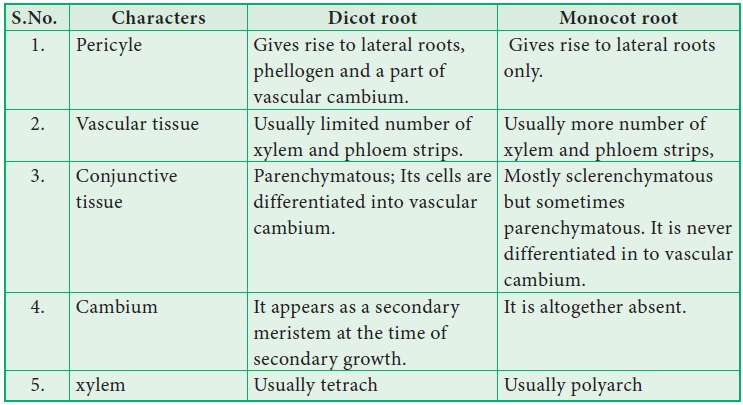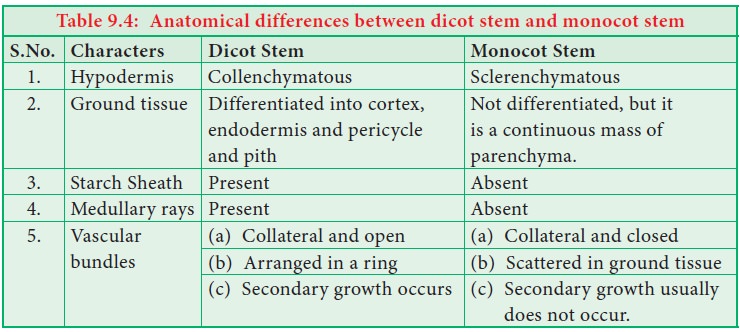Tissue and Tissue System | Botany - Answer the following questions | 11th Botany : Chapter 9 : Tissue and Tissue System
Chapter: 11th Botany : Chapter 9 : Tissue and Tissue System
Answer the following questions
Plant Anatomy (Structural Organisation)
Tissue and Tissue System
6. Why the cells of sclerenchyma and tracheids become dead?
(i) Sclerenchyma and tracheids are cells which have nucleus and cytoplasm (protoplasm) initially but it soon degenerates. They become to the plant.
(ii) Both give mechanical strength to the plant.
(iii) Tracheids being a part of xylem help to conduct water.
7. Explain sclereids with their types.
1. Sclereids-dead cells Isodiametric-but some elongated.
2. Cell wall is very thick due to lignification
3. Lumen - much reduced
4. Pits - may be simple or branched.

TYPE NAME & NATURE
1. BRACHY SCLEREID OR STONE CELLS:
Isodiametric, with hard cell wall - due to lignindepostion lumen very much reduced
Occurrence & Function :
Found in the park, pith cortex , hard endeosperm and fleshy portion of some fruits.
Mechanical – suppot
2. MACROSCLEREID OR ROD CELLS
Cells - elongated, rod shaped
Occurrence & Function :
Found in outer seed coat of leguminous plants
Mechanical support
3. OSTEOSCLEREID OR BONE CELLS:
cells - rod shaped with dilated ends, so look like bone
Occurrence & Function : occur in leaves and seed coats
4. ASTROSCLEREID OR STAR CELLS:
cells with lobes diverging from a central body
Occurrence & Function : occur in petioles
5. TR1CHOSCLEREID OR HAIR CELLS:
Hair like then walled cells - Numerous small angular crystals are embedded in the wall
Occurrence & Function : Occur in stem and leaves hydrophyes
6. FILIFORM SCLEREIDS FIBRE CELLS
They are very much elongated fibre like and about 1 mm length
Occurrence & Function : Occur in the leaf lamina of some plants
8. What are sieve tubes ?explain.

i) Sieve tubes are long tube like conducting elements in the pholem formed from a series of cells called sieve tube elements.
ii) The sieve tube elements are arranged one above the other and form vertical sieve tube.
iii) The end wall contains sieve plate.
iv) The sieve elements show nacreous thickenings on their lateral walls.
v) They may possess simple or compound sieve plates.
vi) The function of sieve are believed to be controlled by companion cells.
vii) In mature sieve tube, Nucleus is absent, it contains a lining layer of cytoplasm. A special protein (P. Protein= Pholem Protein) called slime body is seen in it.
viii) In mature sieve tubes, the pores in the sieve plate are blocked by a substance called callose (callose plug). The conduction of food material takes place through cytoplasmic strands. Sieve tubes occur only in Angiosperm.
9. Distinguish the anatomy of dicot root from monocot root.

Dicot root
1. Pericycle : Gives rise to lateral roots, phellogen and a
part of vascular cambium
2. Vascular tissue : Usually
limited number of xylem and phloem strips.
3. Conjunctive tissue :
Parenchymatous; Its cells are differentiated into vascular cambium.
4. Cambium : It appears
as a secondary meristem at the time of secondary growth.
5. Xylem : Usually
tetrarch
6. Pith : Absent
Monocot root
1. Pericycle : Gives rise to lateral roots only.
2. Vascular tissue : Usually
more number of xylem and phloem strips.
3. Conjunctive tissue : Mostly
sclerenchymatous but sometimes parenchymatous. It is never differentiated in to
vascular cambium.
4. Cambium : It is
altogether absent.
5. Xylem : Usually
polyarch
6. Pith : Present
at the centre
10. Distinguish the anatomy of dicot stem from monocot stem.

Dicot root
1. Hypodermis : Collenchymatous
2. Ground tissue :
Differentiated into cortex, endodermis and pericycle and pith
3. Starch Sheath : Present
4. Medullary rays : Present
5. Vascular bundles :
a)
Collateral and open
b)
Arranged in a ring
c)
Secondary growth occurs
Monocot root
1. Hypodermis : Sclerenchymatous
2. Ground tissue : Not
differentiated, but it is a continuous mass of parenchyma.
3. Starch Sheath : Absent
4. Medullary rays : Absent
5. Vascular bundles :
a)
Collateral and closed
b)
Scattered in ground tissue
c)
Secondary growth usually does not occur.
Related Topics